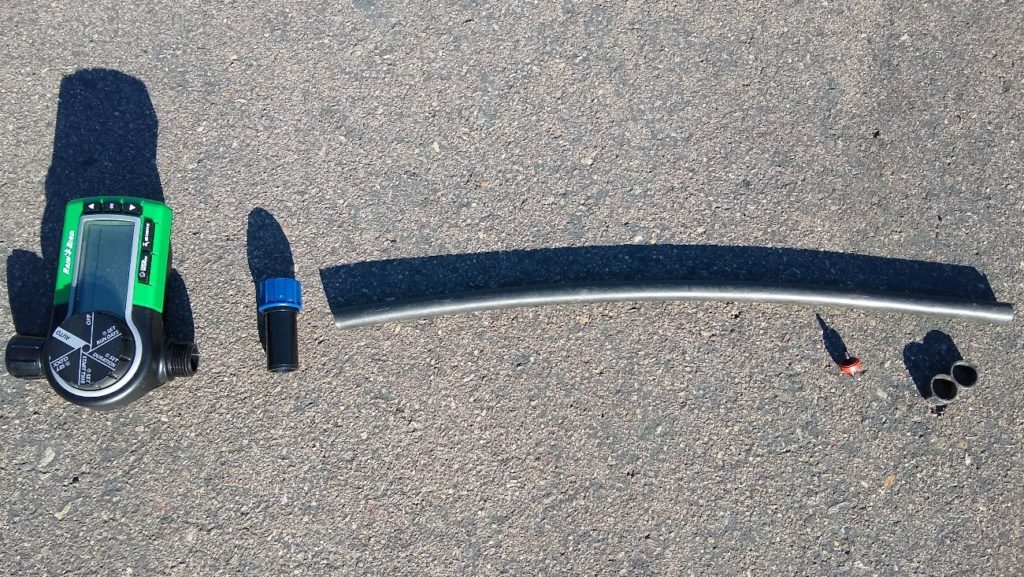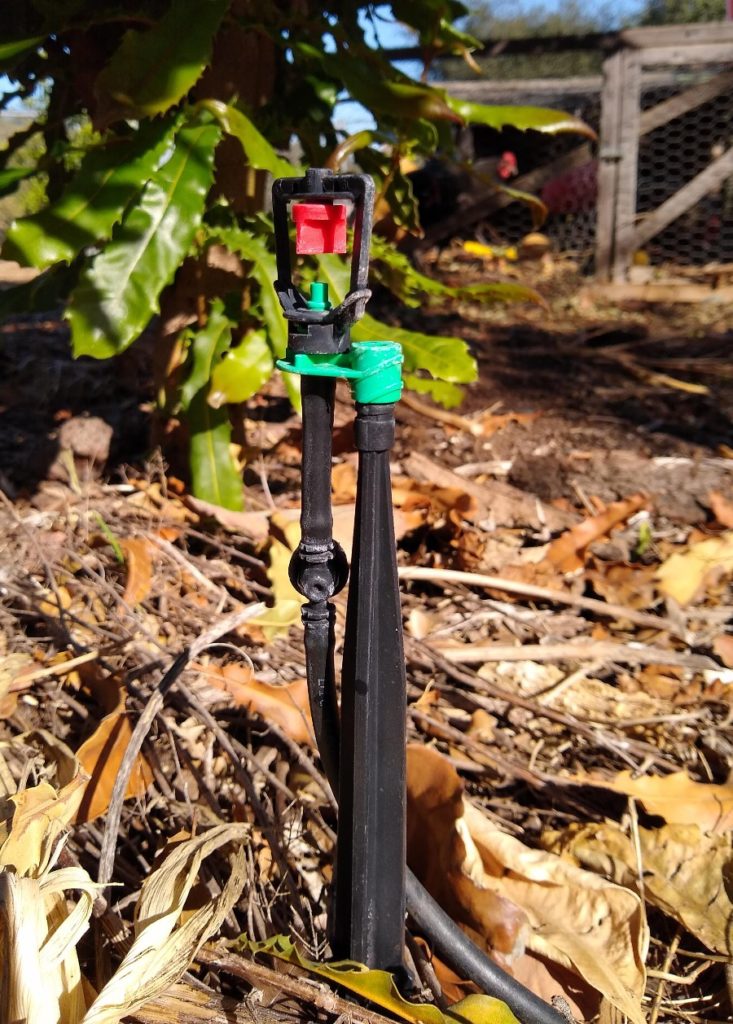Some years back, I wanted to plant fruit trees in a new part of my yard, but there was only a faucet over there. I handwatered the trees at first, but when that work became too much I set up the easiest form of automatic irrigation.
It consists of only five parts. They are parts that are easy to find for purchase and require zero expertise to install.
Maybe your vegetable garden has become too big for you to water by hand, maybe you need some automatic irrigation on a couple fruit trees for when you go on vacation, or maybe you’re just tired of dragging a hose around.
Here are the parts you need and how to put them together, in order to build the easiest automatic irrigation system I know.
Five parts
The names of the five parts are: a hose-end timer, an adapter, a polyethylene tube, an emitter, and a figure eight.
Here’s what they look like, in that order:

Here’s what each does: The hose-end timer attaches to the faucet and allows the water to come out of the faucet on a schedule that you set (for example, every Monday for three hours).
The adapter connects the timer to a tube that will take the water to your plant.
The tube that carries the water is often called poly tube for short, and it is often called half-inch poly tube, referring to its diameter.
The emitter is what lets the water out of the tube next to your plant. There are myriad emitters that let water out in various shapes and quantities. In the photos above, the emitter lets out about two gallons per hour, and it emits the water from one hole. But there are also small sprinklers that can be attached to the tube.
Finally, the figure eight holds the end of the tube closed so that no water comes out there.
Putting the parts together
The five parts go together in the order mentioned and shown above. What will vary with your own installation is the length of the tube as well as the emitters that you attach. The tube can be two feet long or more than two hundred feet long. And it’s possible to water a large vegetable garden or dozens of fruit trees on this same single tube and timer.
Examples
In my yard, I water all of my vegetables using one of these hose-end timer systems. From the main tube I have other tubes with emitters on them running down rows of vegetables.

As I mentioned at the top of the post, in my yard I also use one of these hose-end timers to water a group of fruit trees. Currently, there are 13 fruit trees being watered on this simple system. The emitters I’ve attached to the tube vary: some are drip emitters while others are sprinklers. You can mix them up if you want.

Many people water their gardens successfully using similar simple automatic irrigation with a hose-end timer. I even know a small commercial avocado farmer who waters his grove with a couple of them.
A couple extra notes
Some people will tell you that you must add additional parts to this simple system, and sometimes this is true. Parts you might hear that you need include a filter, a pressure regulator, and a backflow preventer. You can add those parts, but they may be unnecessary according to your situation.
Rather than get into the details as to when and why, I’ll link to my post on troubleshooting drip and micro irrigation, where I talk about some of these components. I’ll also link to Irrigation Tutorials, where you can find more information.
Here I’ll mention that I sometimes go without using a pressure regulator by just opening the faucet valve partially.
If you want to also use a faucet for other things besides your automatic irrigation, you can install a Y or manifold. This way, you can still attach a hose or other things.

Where to buy these parts? They are all available at every hardware store or home improvement center. They are also available at numerous online retailers; just do a web search for “drip irrigation supplies.”
Cost? The hose-end timer is the most expensive unit. It will cost roughly $35. If you were trying to water ten fruit trees, all of the rest of the parts would only cost around $30, for a total price of approximately $65. I’ve found that that’s a small price for the amount of time and energy that such a simple system can free up.
All of my Yard Posts are HERE




Ok. How often and for how long does your system run each week or maybe just this week? I know it varies based on many factors but just as an example.
Hi David,
As you say, there are many factors to consider when determining how long and how often to water. But I love to have examples too. This past week I ran the drip lines on my vegetables for three hours; one hour each on Monday, Wednesday, and Friday. I ran the drip lines and micro-sprinklers on my citrus and avocado trees for four hours; two hours on Monday and two hours on Thursday. (I didn’t water my deciduous fruit trees at all.) This is more than usual for the end of October, but the weather has been warmer, windier, and drier than usual for the end of October.
To make much sense of those run times and frequencies, you’d want to know that I’m using a single drip line per row of vegetables with 0.5 gallon-per-hour emitters spaced every 9 inches. And the drip lines and micro-sprinklers on the fruit trees vary, but in general each tree receives a wetted pattern out to its canopy edge.
A couple posts that you might find interesting:
How long to run drip irrigation on vegetables
My watering schedules for vegetables and fruit trees
DIG is or will be offering a solar powered hose end sprinkler timer . I bought one to try out because I got tired of replacing the 9v batteries in my six irrigation sets (that look like yours) . Love it so far (3 months installed). I will be buying more when they are back in stock.
Thanks, Marilyn. I’ve never used DIG’s solar-powered timers, but I’ve been curious to try one. I’ve wondered about their durability.
So far, so good. If anything goes wrong, I’ll let you know. This is actually the second one. The first only worked a week and the two halves separated due to a missed glue weld. I took it over to Vista to the DIG mfg place and the QC manager was totally apologetic and exchanged it for a new one. He said they were changing over to a new factory, and the one i had purchased from the hardware store was from the old factory.
Thanks, Marilyn. In my dealings with folks at DIG I’ve also found them extremely responsive and helpful.
Would you consider selling avocado scions? I want to graft a tree with multiple kinds of avocados, but I’m having trouble finding a place to buy scions.
Hi Monty,
I completely understand the difficulty here. I plan to write a post about avocado scion sources soon. Thanks for reminding me. Let me know which varieties you’re looking for and I’ll try to connect you with a source.
Reed
Kahaluu
Jan boyce
Green gold
Greg, thanks so much for this blog; so much great info for beginners like myself.
We recently bought 4 young avos to plant this spring (sir prize, Pinkerton, hass, reed). I’ve seen you mention your preference for the micro sprinklers over drip for the avos. Is there a post where you talk about why exactly that is, so I can check it out?
Thanks sir!
Excellent question, Nick. My personal preference for micro-sprinklers over drip comes with caveats and exceptions. I should write a post dedicated to the topic.
The bottom line is that I don’t think micro-sprinklers are better than drip for avocados in general. I’ve seen avocado trees do very well on drip close to the beach (in other words, where it isn’t often over 100 in the summer) and on young trees everywhere (including my own young trees in a hot, inland location). I’ve also seen medium-sized trees growing well in a hot, inland location (Riverside) when they were irrigated often (three days per week in summer, minimum) and on a flat, deep, loamy soil.
Understood. Thanks for the reply! And I’ll look forward to the post if you get there.
We are down in Bonita (5 miles inland), and our trees are babies, so I’m leaning toward drip based on local recommendations as well.